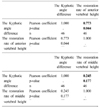Abstract
Purpose
To evaluate the risk factors related to the development of new fractures in adjacent vertebrae after vertebroplasty.
Materials and Methods
The study was conducted on 46 patients in whom 296 patients were performed during last 9 years. We were especially concerned with the restoration rate of vertebral height and kyphotic angle and estimated them on simple X-ray films.
Results
In patients experienced subsequent vertebral fractures and no subsequent vertebral fractures after vertebroplasty, the mean height restoration rate of treated vertebra were 16.7% and 7.07%, and the kyphotic angle difference were 2.53 degree and 4.2 degree. The greater degree of height restoration of the vertebral body, especially in middle vertebral height and the lesser degree of kyphotic angle difference increased the risk of adjacent vertebral fracture risk. This results were available statistically (all p<0.05, Logistic regression test, SPSS 13.0).
Figures and Tables
 | Fig. 372 year-old female visited in our hospital because of back pain after vertebroplasty of T12 Without trauma history. (A) Simple radiograph and (B) Magnetic Resonance Image after 6 months since T12 vertebroplasty in local clinic. The large amount of cement augmented in midportion of vertebral body. |
References
1. Baroud G, Nemes J, Ferguson SJ, Steffen T. Material changes in osteoporotic human cancellous bone following infiltration with acrylic bone cement for a vertebral cement augmentation. Comput Methods Biomech Biomed Engin. 2003; 6:133–139.

2. Belkoff SM, Mathis JM, Erbe EM, Fenton DC. Biomechamical evaluation of a new bone cement for use in vertebroplasty. Spine (Phila Pa 1976). 2000; 25:1061–1064.
3. Berlemann U, Ferguson SJ, Nolte LP, Heini PF. Adjacent vertebral failure after vertebroplasty. A biomechanical investigation. J Bone Joint Surg Br. 2002; 84:748–752.
4. Delmas PD, Ensrud KE, Adachi JD, et al. Efficacy of raloxifene on vertebral fracture risk reduction in postmenopausal women with osteoporosis: four-year results from a randomized clinical trial. J Clin Endocrinol Metab. 2002; 87:3609–3617.

5. Evans AJ, Jensen ME, Kip KE, et al. Vertebral compression fractures: pain reduction and improvement in functional mobility after percutaneous polymethylmechacrylate vertebroplasty retrospective report of 245 cases. Radiology. 2003; 226:366–372.

6. Ferguson SJ, Berlemann U, Heini PF, Nolte LP. Evaluation of adjacent segment failure following vertebroplasty. Orthop Res Soc. 2001; 280:362–637.
7. Hwang J, Kim C, Kim J. Vertebroplasty in the treatment of osteoporotic compression fracture more than 1 year follow up. J Korean Fract Soc. 2004; 17:368–373.

8. Jensen ME, Dion JE. Percutaneous vertebroplasty in the treatment of osteoporotic compression fractures. Neuroimaging Clin N Am. 2000; 10:547–568.
9. Kim SH, Kang HS, Choi JA, Ahn JM. Risk factors of new compression fractures in adjacent vertebrae after percutaneous vertebroplasty. Acta Radiol. 2004; 45:440–445.

10. Kumpan W, Salomonowitz E, Seidl G, Wittich GR. The intravertebral vacuum phenomenon. Skeletal Radiol. 1986; 15:444–447.

11. Liebschner MA, Rosenberg WS, Keaveny TM. Effects of bone cement volume and distribution on vertebral stiffness after vertebroplasty. Spine (Phila Pa 1976). 2001; 26:1547–1554.

12. Lindsay R, Silverman SL, Cooper C, et al. Risk of new vertebral fracture in the year following a fracture. JAMA. 2001; 285:320–323.

13. Min SH, Kim MH, Park HG, Paik HD. A clinical analysis of 260 percutaneous vertebroplasty in the treatment of osteoporotic compression fracture. J Korean Fract Soc. 2006; 19:357–362.

14. Polikeit A, Nolte AP, Ferguson SJ. The effect of cement augumentation on load transfer in an osteoporotic functional spine unit. Spine (Phila Pa 1976). 2003; 28:991–996.

15. Schlaich C, Minne HW, Bruckner T, et al. Reduced pulmonary function in patients with spinal osteoporotic fractures. Osteoporos Int. 1998; 8:261–267.





 PDF
PDF ePub
ePub Citation
Citation Print
Print








 XML Download
XML Download